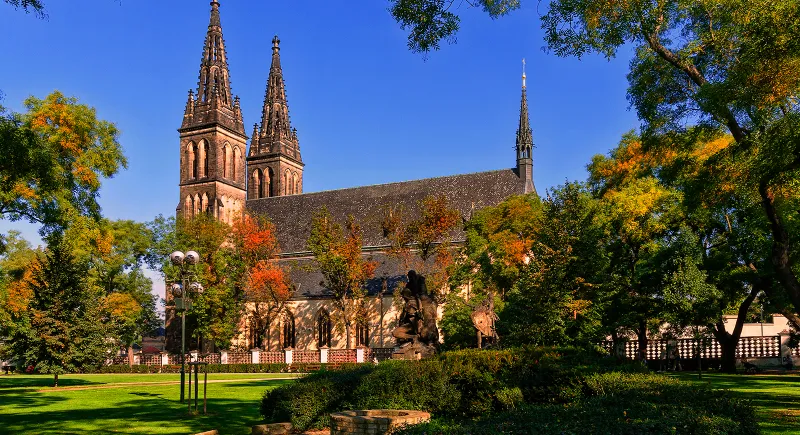
Off the beaten tracks
Vyšehrad stands usually aside the frequented tourist routes, as it is located further from the areas that are considered city centre of Prague, on the east bank of the river, about 3 km from the Prague castle. And yet, it is a place essential for the Czech history since the very beginning of the pre-medieval settlement of the country, a place which should not be missed if you want to understand the centuries of the development of the state.
Important role in Czech mythology
Vyšehrad plays a significant role in many Czech myths and legends – a fact that is valid since the early middle ages – already in the first famous written chronicle of the kingdom – the Kosmas chronicle – is the place described as a seat of mythological Czech figures – the princess Libuše and her husband Přemysl, the mythological founders of the Přemyslid ruling genus. Much later, also the emperor Charles IV made efforts to base his legacy back on those places, where this side of his family (from hismother, Eliška Přemyslovna) settled and founded the dynasty that ruled over the country for several centuries.
Situated on a strategic position
The reason why the first Přemyslid princes settled here is obvious – a hill that is protected by a sharp rock on the Vltava side, and encircled by steep slopes on all the other sides except for one narrow access trail – an ideal position in terms of defence, but at the same time very close to the river – to water source and transport and communication way. Not endangered by floods, as was the area down the river, where the city of Prague was built later…
The first settlement
All we know about the very beginning of the Přemyslid settlement is actually very little: probably in the 10th century a palace was constructed here – the first stone palace in the country, older then Prague Castle. The archeologists have researched only 15% of the area till nowadays… Standing on the view platform overlooking the city today, you have the remnants of the old palace underneath your feet… And there are many, many interesting facts related to it: there was most probably the first Czech silver and gold foundry and coinage in these places, too, and perhaps also – on the slope under the palace – the first international settlement of traders and merchants including Jews.
Religious buildings
Also a very early church was constructed – a small temple of St. Clement of Rome – the saint patron, one of the Apostolic fathers, who was considered the successor of Saint Peter and whose bones were allegedly found by St.Cyril and Methodius – the two Christian monks from the Byzantine Empire, who brought the new belief to the Czech and Moravian lands. In the Christian hagiographical history, St. Clement became a patron-saint of marines, his main attribute being the anchored cross (according to a legend, he was drowned in the Black Sea with an anchor tied around his neck) – rather a paradox in the inland country.
A centre of religious life
The Basilica of St. Petrus and Paulus, which stands in the centre of Vyšehrad today– certainly in an altered image – was founded by the first Bohemian king Vratislaus II. in 1070. But Vratislaus has originally built here two basilicas – also another one dedicated to St. Laurentius. Doing so, the early Přemyslid princes and kings wanted to consolidate the position of Vyšehrad in their political game. And the whole place started to acquire a very pious character in the following centuries – some historicians write there were 14 churches and chapels on this relatively small area at the beginning of the 15th century. To our days, only one of them remained more or less in its original structure – the round chapel of St. Martin, built probably before 1171. All other Vyšehrad buildings were largely destroyed by the raging Hussite crowds, and most of them has not been re-built or renovated…
Chapel of St.Martin
The chapel of St. Martin, or rotunda, as it is called in the Czech language, survived the Hussite plundering, but its later destiny was troubled: in the Thirty years´war, it served as a storage for gun powder, in 1757, when the Prussians besieged Prague, it got a few shots from cannonballs (one of the balls is visible till nowadays, stuck into the stones), and after the reforms of Joseph II., it was converted into an army facility, used as a workshop for making fire charges and cartridges. It was refurbished back into a cchapel only in the late 19th century…
The legends embodied
Our short excursion into the oldest history of Bohemia in Vyšehrad can be finished in the park in front of the statues depicting the legendary Czech figures: Libuše and Přemysl, Ctirad and Šárka and others. The statues were made by not less legendary sculptor Josef Václav Myslbek (he made also the Saint Wenceslaus statue at the top of Wenceslas square), and were originally made for the Palacký bridge underneath the hill. The bridge was unfortunately largely destroyed during the bombing of Prague in 1945, and the statues got here to Vyšehrad – they could not have found a better domicile…
